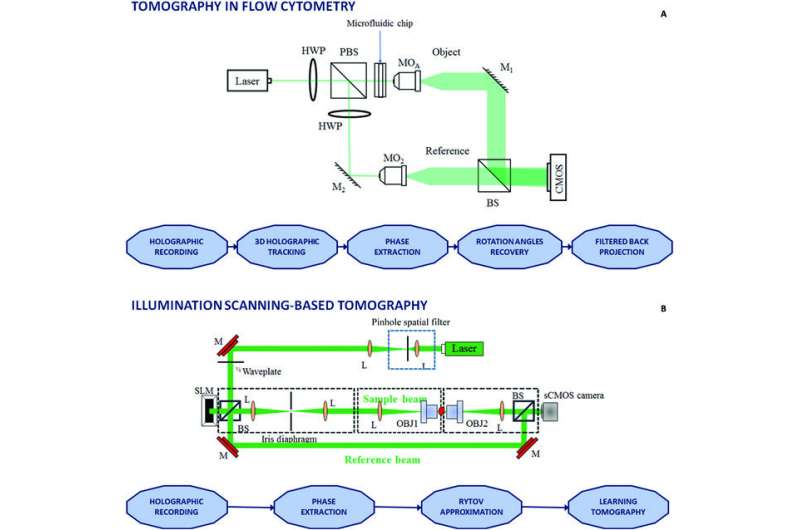This article has been reviewed according to Science X's editorial process and policies. Editors have highlighted the following attributes while ensuring the content's credibility:
fact-checked
proofread
New method shrinks 3D images of cells for faster storage and retrieval

Single-cell analysis is a powerful biomedical technique used in various fields of biology and medicine to identify rare cell populations, track cell development and differentiation, understand disease mechanisms and develop personalized therapies, but it generates large amounts of data that can be difficult to manage.
An international team of researchers led by Demetri Psaltis of the Swiss Federal Institute of Technology Lausanne and Pietro Ferraro of the Institute of Applied Sciences and Intelligent Systems has demonstrated an effective encoding strategy for single-cell tomograms that greatly streamlines the handling and storage of single-cell data while maintaining fidelity.
Their research was published Jan. 11 in Intelligent Computing.
The new method proposed by the authors can effectively manage and process the vast datasets generated by tomographic phase microscopy, a popular technique for single-cell studies. This technique can rapidly produce 3D images of living cells and tissues without damaging the sample, making it a valuable tool for studying cellular dynamics such as division, migration and differentiation.
A major challenge currently faced in tomographic phase microscopy is effectively managing massive quantities of 3D data to achieve swift and accurate cellular diagnosis. The new method can achieve a data compression ratio of 22.9. This means that big-data single-cell tomograms can be compressed while saving over 95% of space, with less than 1% of information lost.
The strategy works well on various experimental data, including different types of cells with spherical and non-spherical shapes. In fact, it can efficiently process any volumetric images.
In the future, it will be possible to have a lab-on-a-chip tomographic imaging flow cytometry system—a system that employs lasers to measure various characteristics of individual cells as they move through a fluid-filled channel. To achieve this will require a microfluidic module capable of controlling the positions and rotation of the flowing cells using advanced cell manipulation solutions such as multicore fiber.
From the computational point of view, the results reported here open the route to an effective methodology to store, manipulate and process volumetric images, especially for lab-on-chip systems, which require a small memory footprint. The results demonstrated here will lead to further developments in computational microscopy for single-cell phase-contrast tomography.
The new method is based on the 3D extension of Zernike polynomials. The 3D Zernike representation is a way of describing the shape of an object in three dimensions. It is based on a mathematical concept called spherical harmonics and is especially good at describing objects that are roughly spherical in shape. Cells in the natural environment are often shaped like spheres, so the 3D Zernike representation can be a useful tool for studying them.
The authors demonstrated that the 3D refractive index distribution of a cell can be straightforwardly encoded in one dimension by using 3D Zernike polynomials. They reconstructed a tomographic cell phantom and analyzed its performance by comparing to the most-used volumetric image compression strategies. The method was then validated on real-world single-cell tomography data.
More information: Pasquale Memmolo et al, Loss Minimized Data Reduction in Single-Cell Tomographic Phase Microscopy Using 3D Zernike Descriptors, Intelligent Computing (2023). DOI: 10.34133/icomputing.0010
Provided by Intelligent Computing


















